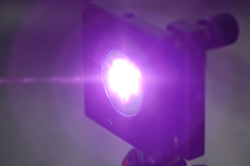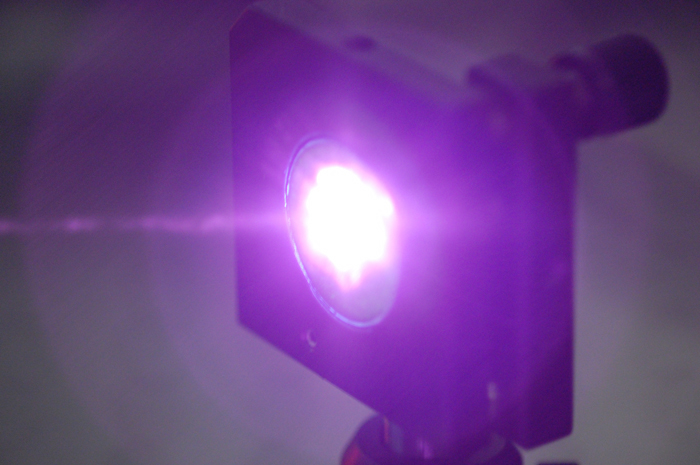Hearing the Highest Pitches
Sound waves in a solid with wavelengths not much longer than the distance between atoms can potentially probe material properties almost on atomic scales. But detecting such vibrations is no easy feat. Reporting in the 4 and 11 July issues of Physical Review Letters, two research teams offer new ways to detect these vibrations, paving the way for studies of nanostructures, thin films, and interfaces between materials with high resolution in both space and time.
Jiggling of the atoms in a crystal gives rise to vibrational waves known as phonons, which can transport sound, heat, and other forms of energy through a solid. Measurements of phonon properties provide information on crystal structure and the forces among atoms. Phonons are often detected through their interactions with light, but when phonon wavelengths are similar to interatomic distances, much smaller than visible light wavelengths, such methods become ineffective. Although researchers believe they have produced short-wavelength phonons in the past, they haven’t been able to detect them directly or control them very precisely.
To create short-wavelength phonons, Mariano Trigo of the University of Michigan in Ann Arbor and his colleagues began with a technique previously used by others. They shot 50-femtosecond laser pulses at a nanostructure of alternating, several-atom-thick layers of gallium-indium arsenide and aluminum-indium arsenide. This so-called superlattice sat on top of a crystal of indium phosphide, the “substrate.” Because the two superlattice materials absorb light energy with different efficiencies, the laser pulses could excite terahertz frequency phonons of a special kind: the two several-atom-thick layers within each pair moved alternately toward and then away from each other.
But the team was then able to take the next step–as the phonons propagated into the substrate, the researchers detected them there using x rays. In the substrate, the superlattice phonons transformed into phonons with the same terahertz frequency and with wavelength approximately equal to the width of the superlattice’s paired layers. Such phonons cannot be excited by visible light directly in the substrate.
Passing through the substrate, these phonons briefly distorted its atomic structure. The researchers flashed the substrate with 100-picosecond x-ray bursts generated by the Advanced Photon Source at Argonne National Laboratory in Illinois. The x-ray flashes were not brief enough to give true instantaneous snapshots of the substrate’s atomic structure. But by timing the x-ray bursts relative to the laser pulses, the researchers could detect the progression of changes in the x-ray diffraction pattern during the passage of the phonons through the substrate. These x-ray data agreed with their predictions from computer simulations.
In their proposal of a different technique, Evan Reed of Lawrence Livermore National Laboratory in California and his colleagues used a computer simulation including millions of atoms. They modeled a brief, intense laser pulse sending a shock wave through a crystal of gallium nitride connected to a crystal of aluminum nitride. The leading edge of the shock created terahertz phonons that crossed into the aluminum nitride.
Both gallium nitride and aluminum nitride are piezoelectric, meaning they generate electric currents in response to squeezing or stretching of the crystalline lattice. Phonons traveling through each crystal generated no net current because simultaneous expansion and contraction of the lattice canceled. But as the phonons crossed the boundary between the two materials, the difference between their piezoelectric responses led to the appearance of currents. A sensor a few millimeters away could then detect the fields produced by the currents, the researchers showed.
Because currents appear only at the interface between the two materials, measurements of the transient fields allow the atomic motion at that boundary to be calculated with very fine time resolution, Reed explains. High-frequency phonons often show up in simulations of shock waves in materials but haven’t yet been observed, he adds, so such experiments “could verify that these oscillations really do happen.”
Richard Averitt of Boston University notes that experiments along the lines proposed by Reed and his colleagues could be quite difficult but says the technique could allow novel investigations, for example of shock physics at or near the atomic scale. The work by Trigo’s group, meanwhile, holds promise for further experiments that would take advantage of the new high-intensity femtosecond x-ray facilities to study phenomena such as nanoscale heat transport. “It will be exciting to see how the experiments in these areas play out over the next several years,” Averitt says.
–David Lindley
David Lindley is a freelance science writer in Alexandria, Virginia.





